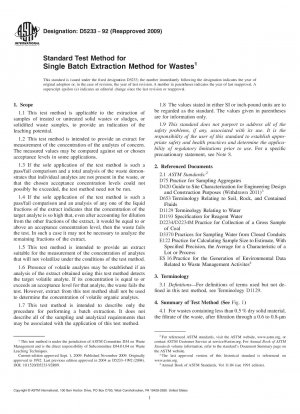ASTM D5233-92(2009)
Standard Test Method for Single Batch Extraction Method for Wastes
- Standard No.
- ASTM D5233-92(2009)
- Release Date
- 1992
- Published By
- American Society for Testing and Materials (ASTM)
- Status
- Replace By
- ASTM D5233-92(2017)
- Latest
- ASTM D5233-92(2023)
- Scope
This test method is intended to generate an extract with a concentration of the target analyte(s) representative of the expected release under the scenario simulated, and which can be compared with concentration levels acceptable in waste disposal, treatment, or production activities.
The extraction conditions of the test method were chosen to simulate a potential disposal scenario to which the wastes may be exposed.
One intent of this test method is that the amount of acid in the extraction fluids reflect the acid available from the leachate of a specific landfill where municipal and industrial wastes were co-disposed.
One intent of this test method is to not allow the pH of the extraction fluid to be lower than that of the leachate of a specific landfill where municipal and industrial wastes were co-disposed. Therefore, the pH of the extraction fluid was chosen with the following considerations:
(1) Not to be less than 4.93 ± 0.05 for the extraction of wastes with an acid neutralization capacity of less than the acid available in the total volume of extraction fluid used in the method (Extraction Fluid No. 1).
(2) At 2.88 ± 0.05, as defined by the pH of the acid, for the extraction of wastes with an acid neutralization capacity of more than the acid available in the extraction fluid used in the method (Extraction Fluid No. 2).
The interpretation and use of the results of this test method are limited by the assumptions of a single co-disposal scenario and by the factors affecting the composition of a landfill leachate and chemical or other differences between a selected extraction fluid and the real landfill leachate.
This test method may be affected by biological changes in the waste, and it is not designed to isolate or measure the effect of such processes.
This test method produces extracts that are amenable to the determination of both minor and major constituents. When minor constituents are being determined, it is especially important that precautions be taken in sample storage and handling to avoid possible contamination of the samples.
The agitation technique, rate, liquid-to-solid ratio, and filtration conditions specified in the method may not be suitable for extracting all types of wastes.
This test method is intended to extract the samples in their original physical state as is, without any size reduction. However, the sample/extractor interaction is expected to correlate with the environmental conditions to which a waste may be exposed.
The extraction conditions defined by this test method are expected to yield steady-state concentrations, determined by the extraction liquid-to-solid ratio and the duration of the extraction, which may or may not agree with the concentration of an equilibrium.
1.1 This test method is applicable to the extraction of samples of treated or untreated solid wastes or sludges, or solidified waste samples, to provide an indication of the leaching potential.
1.2 This test method is intended to provide an extract for measurement of the concentration of the analytes of concern. The measured values may be compared against set or chosen acceptance levels in some applications.
1.3 If the sole application of the test method is such a pass/fail comparison and a total analysis of the waste demonstrates that individual analytes are not present in the waste, or that the chosen acceptance concentration levels could not possibly be exceeded, the test method need not be run.
1.4 If the sole application of the test method is such a pass/fail comparison and an analysis of any one of the liquid fractions of the extract indicates that the concentration of the target analyte is so high that, even after accounting for......
ASTM D5233-92(2009) Referenced Document
- ASTM D1129 Standard Terminology Relating to Water*, 1999-04-19 Update
- ASTM D1193 Standard Specification for Reagent Water*, 1999-04-19 Update
- ASTM D2234/D2234M Standard Practice for Collection of a Gross Sample of Coal*, 2020-04-01 Update
- ASTM D3370 Standard Practices for Sampling Water from Closed Conduits*, 1995-09-10 Update
- ASTM D420 Standard Guide to Site Characterization for Engineering Design and Construction Purposes *, 1998-04-19 Update
- ASTM D653 Standard Terminology Relating to Soil, Rock, and Contained Fluids*, 1997-04-19 Update
- ASTM D75 Standard Practice for Sampling Aggregates*, 1997-04-19 Update
- ASTM E122 Standard Practice for Calculating Sample Size to Estimate, With a Specified Tolerable Error, the Average for Characteristic of a Lot or Process*, 2000-10-10 Update
ASTM D5233-92(2009) history
- 2023 ASTM D5233-92(2023) Standard Test Method for Single Batch Extraction Method for Wastes
- 1992 ASTM D5233-92(2017) Standard Test Method for Single Batch Extraction Method for Wastes
- 1992 ASTM D5233-92(2009) Standard Test Method for Single Batch Extraction Method for Wastes
- 1992 ASTM D5233-92(2004) Standard Test Method for Single Batch Extraction Method for Wastes
- 1992 ASTM D5233-92(1999) Standard Test Method for Single Batch Extraction Method for Wastes
